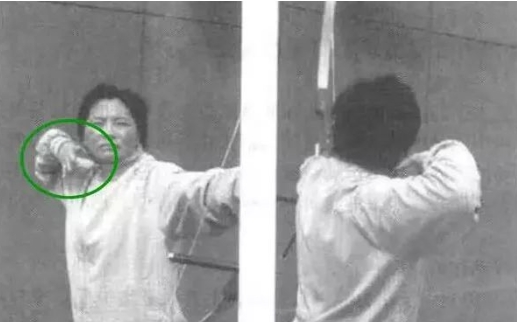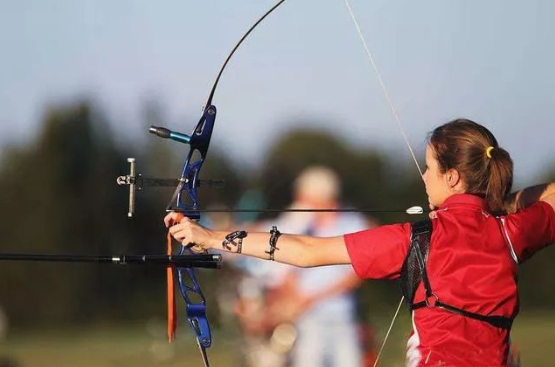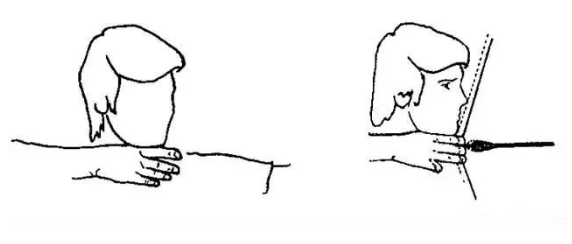Release time:2024-12-18 14:57:54Clicks:author:SPG ArcheryMain categories:Bows, Arrows, Archery Accessories
The hand that pulls the string is raised outward
This is a common release error, which is manifested as: the hand that pulls the string is tilted to the right (left for left-handed shooters) when releasing, changing the original force direction, destroying the linear force, and causing the arrow to land on the right (left).

Demonstration of the error of the hand that pulls the string outward
Stabilize the force direction of the pusher, strengthen the force of the back muscles, and drive the bow arm to move backward through the back force. When the back is correctly exerted, the muscles of the upper and lower arms should feel clamped.
The hand that pulls the string should not leave your jaw and neck during the release and backward movement. If you are not used to it, you can apply talcum powder on the jaw and neck to reduce friction.
Avoid the extensor muscles from participating in the release action. While the flexor muscles give way, the back force drives the bow arm to achieve a favorable backward pull.
The hand that pulls the string inward
This error is exactly the opposite of the hand that pulls the string outward, specifically: the hand that pulls the string is tilted to the left (right for left-handed shooters) when releasing. This wrong posture will also cause the arrow's flight trajectory to deviate, causing the arrow to land to the left (right).

Demonstration of the wrong inward pull of the hand
While keeping the back muscles working, relax the bow arm and wrist, and relieve a certain degree of muscle tension through the arm rotation movement.
Clear the distracting thoughts in your mind, focus on the movement, feel the muscle force, adjust your attention through breathing, and encourage yourself to calm your emotional fluctuations through inner dialogue.
During the release process, the hand holding the string should exert force naturally, and do not deliberately increase the force. After the release, the finger holding the string will naturally retreat with the lower jaw and neck.
Pressing the hand holding the string down
Instead of moving backward along the horizontal line, it moves below the horizontal line, causing the force direction to deviate and change the arrow's flight trajectory. When this error occurs, the arrow's landing point is prone to deviate, and the direction is mainly the up and down direction of the normal landing point.
Demonstration of the wrong downward pull of the hand holding the string
When doing the bow opening action, do not deliberately increase the force of the back elbow, and maintain a natural and comfortable angle.
Choose professional release training devices such as elastic bands and rubber tubes, practice bow drawing in front of a mirror, and then correct the action.
Practice in the archery hall or under the guidance of other professionals, let others give timely feedback on the archery posture, and make adjustments independently.
String hand forward delivery
Specifically means: when releasing, the string hand moves in the direction of the bow hand following the bowstring. There are two ways of performance. One is that when releasing, the string hand only extends the fingers without moving back. When the bowstring leaves the fingers, the bow arm drives the string hand to move backward. The other is that after the signal piece falls, the string hand is sent forward for a distance, and then the release action is performed.

Demonstration of wrong forward delivery of the string hand
1. Install the signal piece, exert force on the back muscles, maintain continuous force when opening the bow, and release when the signal piece sounds.
2. Archers who install signal plates need to improve their understanding of the equipment used, grasp the timing of the signal plate, and remember the muscle movement position at this time. The bow arm continues to draw back, and the string hand naturally releases and withdraws.
3. Focus on the control of each body muscle and think about the movement feeling when each arrow is shot.